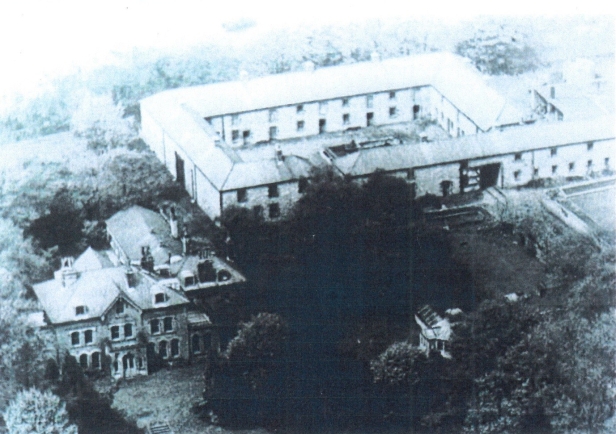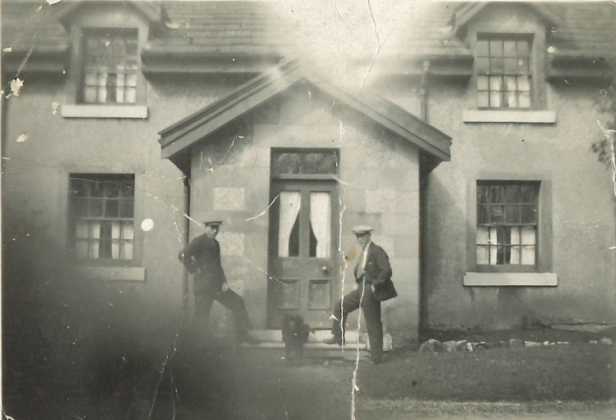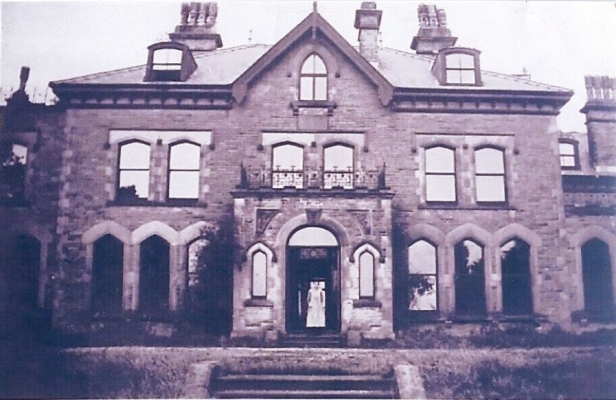At one time there was a rather grand house in Green Fairfield.
Hardybarn Lane is a long single track running from Waterswallows Road and ending just short of the Buxton to Bakewell A6. As you head down it you are all too aware of the huge Tunstead Quarry nibbling away at the land a few metres away to the east. The quarry is fenced off with danger notices and ‘Beware of Cliff Edge’ signage, periodically there are concrete igloo blast shelters close to its cliff edge perimeter.

Between the fence lining the road and the quarry’s raw edge is a no man’s land where amongst the native flora rhododendrons bloom and if you wander through where you shouldn’t there is a monkey puzzle tree towering majestically above the ash and sycamore. Close by there is evidence of a tree lined driveway running from the lane straight to the great drop into the quarry.
An online search on ‘side by side maps’ (1) where you can compare old maps with satellite images illustrates two driveways; one straight leading to out buildings with a court yard and one further down the lane with a gate house, winding through formal gardens to a much larger house.
It was called Orient Lodge.

I googled the name and Buxton Civic Association (2) have a link which revealed something of its history from Alison Wilton whose family lived in nearby Daisy Mere Farm, which still stands today.

Built in 1896 for Samuel Swann Brittain and his Arabic wife Emma there are accounts of the grand house of Orient Lodge employing dairy staff, farm workers and servants. Originally the grounds were open farmland but the Brittains landscaped the estate with formal gardens and planted mature trees from Ashwood Dale and overseas. There are tales of an orangery filled with exotic fruit trees, beautifully built stables for a stud farm and shippons with luxuriously tiled interiors.
It is said that Samuel Brittain spoke seven languages and that the couple had business interests in tea and cotton from Egypt, India and Africa. They lived in the house throughout the First World War until the 1920’s when it said that an uninsured shipment of tea sank resulting in them getting into financial difficulties. They began to pay their farm manager Ben Bingham in land in lieu of wages owed and by the early 1930’s he owned the whole estate.



Shortly after discovering the name of the house, a lady visited the museum whose mother, Audrey Evans used to live in the gate house of Orient Lodge.
Audrey paid us a visit at the museum, bringing along photographs and accounts of life in the gate house with her parents Norman and Ivy Smith and her elder sister Thelma.


Audrey’s time living on the estate during the 1930’s was when the estate was owned and occupied by the Bingham family. She revealed that the winding driveway was for the main house and the straight tree lined entrance was strictly for trades people and staff leading directly to the stables and dairy.

Audrey remembers the Bingham’s having three children; Wilf, Mary and Robert. Spending much of her time with ‘Mary from the diary’, she recalls great vats of cheese being produced in this large single storey annexe at the back of the main house. She recounts memories of a huge kitchen with numerous sinks, a range, a piano and long forms where former staff would have sat down to eat.
She also caught glimpses of inside the main house where there was a large staircase, grand fireplaces of marble and ornate covings and heard the accounts of how the Bingham’s came to acquire the house from the Brittians. Audrey believes that Emma Brittian originated from Sudan, others say Egypt, but both tally in with tales of a tall dark lady descending a staircase wearing a yashmak and striking, brightly patterned silk robes.
Norman Smith walked to work each day at nearby Tunstead quarry when it was much smaller than it is today. She recalls that one winter morning Norman trudged through snow numerous feet deep on the lane to find he was the only worker to have made the journey in to work. He received a half crown for his efforts.
Audrey’s sister Thelma attended the primary school on Queens Road in Fairfield, a long walk for such a small child. She remembers her father teaching Thelma to ride a bike and then painstakingly constructing and fixing a metal seat to the front of a bicycle so her mother Ivy could cycle with them both along Waterswallows Road to school.
In 1936 the Smith family moved closer into Buxton but Audrey still recalls returning to visit Mary at Orient Lodge. During the war years she recalls seeing the grand rooms on the ground floor stacked with sacks of grain and the Bingham’s retreating to the servant’s quarters of the house.

Quarrying began at Tunstead in 1929 and gradually expanded, moving closer to Orient Lodge. By the mid 1930’s the Binghams had already sold part of the land to I.C.I. By this time it was Robert Bingham who owned the estate and he came to an agreement with I.C.I. to limit the approach of the quarry with penalties attached if the agreement was breeched. The quarrying did indeed approach faster than agreed and Robert Bingham received significant compensation.
Robert kept the house on until he died in 1977 before its inevitable sale to I.C.I.
Audrey remembers that Wilf, Robert and Mary had no children of their own and the £70,000 from the sale and proceeds from the Bingham family’s compensation funded The Bingham Trust (3) which continues to serve to relieve poverty in Buxton and Fairfield and to fund the provision of educational services.
What became of Samuel and Emma Brittain I am not sure. Online war records reveal a son, Major Edward Samuel Brittian of Orient Lodge. He served in France in 1915 in the Royal Field Artillary and then in Sudan where he died in 1923 aged just 31. He is commemorated in St. Peter’s Church in Fairfield.

One of the last uses of the house was a test bed to assess the damaging effects of different blasting techniques on nearby buildings.
Orient Lodge was demolished in 1978, its dressed stone auctioned off, its carved marble fireplaces with Egyptian pelicans sold and distributed and much of its land consumed by the quarry.
References:
(1) Scottish National Library/ side by side maps:
http://maps.nls.uk/geo/explore/side-by-side/#zoom=17&lat=53.2662&lon=-1.8637&layers=6&right=BingHyb
(2) Buxton Civic Association
https://buxtoncivicassociation.org.uk/tag/orient-lodge/
(3) The Bingham Trust
Further links:
https://www.militaryimages.net/media/edward-samuel-brittain.120852/
https://www.flickr.com/photos/galleria_de_magnifique/4737424326


Interesting article, thanks, I love hearing the older memories. But so sad that beautiful house was demolished! I know upkeep is pricey, but such as shame it was lost, & it’s not like we still have the talent or care post 1950s to build anything even a teenth as attractive 😦
LikeLike
We’re glad you enjoyed it.
LikeLike